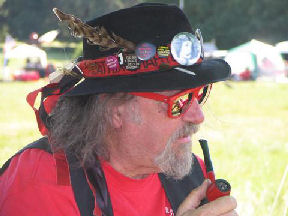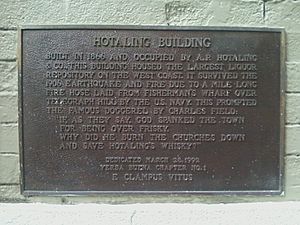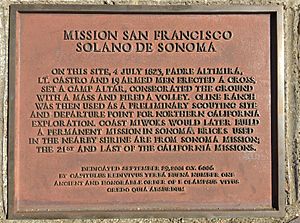E Clampus Vitus facts for kids
The Ancient and Honorable Order of E Clampus Vitus (ECV) is a unique club for men. It's like a special brotherhood that works to protect the history of the American West. They especially focus on the history of the Mother Lode and gold mining areas. You can find chapters of this group in many states, including California, Nevada, Arizona, and more. Members call themselves "Clampers." The group's name is in a playful, made-up Latin, and its exact meaning isn't known. Their motto, Credo quia absurdum, means "I believe it because it is absurd." This shows they don't take themselves too seriously!
Contents
A Look Back: The History of E Clampus Vitus
The First Days of ECV
The ECV loves to tell tall tales about its members. They jokingly claim famous people like Ulysses S. Grant, J. P. Morgan, and even Julius Caesar were part of their group! These fun stories show that the Clampers enjoy a good laugh and don't take things too seriously.
There's a chance that Ulysses S. Grant might have been a member. He was stationed in Benicia, an early capital of California, around the time the group was growing. Given the group's friendly nature, it's possible he joined.
Members say the ECV started in the United States in 1845 in Lewisport, Virginia (now West Union, West Virginia). A man named Ephraim Bee, who owned an inn, claimed he got a special message from the Emperor of China. This message told him to spread the word of the ECV. A monument to Ephraim Bee stands today where his old inn used to be.
Ephraim Bee was a local leader who helped protect his area. He also played a big part in helping people find freedom during the Civil War. He would even host parties to keep everyone busy while groups of people moved to safety.
The first goal of the ECV was to welcome new members. When a stranger came to town, Clampers would tell him he needed to join their group to do business. The initiation was a funny show, making fun of other serious clubs. After joining, the new member would often buy drinks for everyone.
Bee wanted a club that was open to more people than other groups like the Masons. He welcomed any "upstanding" man who was old enough. ECV chapters popped up in many states. The leader of the group was called the Supreme Grand Humbug, a very silly name!
ECV in the Gold Rush Era
Historians think the ECV came to California during the Gold Rush. A member named Joel Zumwalt is said to have started an ECV lodge in Mokelumne Hill in 1851.
The ECV became very popular because miners liked its fun and lively spirit. Other older clubs were more serious. The Clampers made fun of these groups by wearing red shirts and badges made from tin can lids. This tradition, called "wearing the tin," still happens today. Members often wear a red shirt, black hat, and Levi's jeans. Their titles were also funny, like "Noble Grand Humbug." All members are considered equal, no matter their title.
Clamper meetings were held in places they called the Hall of Comparative Ovations, usually the back room of a saloon. Some chapters even built their own meeting halls. The Clamper flag was a hoop skirt with the words "This is the flag we fight under." New members were called "Poor Blind Candidates." They were asked to bring a small bag of gold dust, but this was often not required if they couldn't afford it.
Even with all the humor, the Clampers were serious about helping each other. If a member got sick or hurt, the group would collect food or money to help. They often traveled through the Sierra Nevada mountains to reach lonely miners, making sure they had a Christmas celebration. The group also helped the wives and children of members who had passed away.
At its busiest, around 1870, so many miners were Clampers that mining towns would close down for ECV parties! Mark Twain was a member. He even heard the story for his famous tale, The Celebrated Jumping Frog of Calaveras County, at an ECV meeting.
ECV Comes Back to Life
The original E Clampus Vitus faded away after the Civil War. But in 1930, a lawyer and historian from San Francisco named Carl Irving Wheat brought the group back. This new version of ECV is still fun, but it also focuses more on being a historical society. You can now find ECV historical plaques on many buildings across California.
Wheat and his friends, G. Ezra Dane and Leon O. Whitsell, were contacted by one of the last original Clampers. This old member shared all he remembered about the group's traditions. They started a new chapter, Yerba Buena Number 1. Wheat called E Clampus Vitus "the comic strip on the page of California history," showing its fun side.
New chapters started in other cities. At first, they were numbered simply. But then, members decided such a fun group shouldn't be so neat! So, they got creative with chapter numbers. For example, the "Pair-o-Dice" chapter in Paradise is Lodge No. 7-11.
In 1936, a metal plate appeared in Northern California. It claimed to be from Sir Francis Drake and said he had claimed California for England. The local Miwok Indian chief, William Fuller, was an ECV member. At an ECV meeting, he jokingly gave the land to the United States government instead! This "Drake's Plate of Brass" was later found to be a hoax (a trick) that got out of hand.
ECV Today: Preserving History
In 1991, there were about 50,000 Clampers in 62 chapters. Today, there are 46 ECV chapters in many Western states. There are even special online and offshore chapters!
New chapters continue to form. For example, the Doc Maynard Chapter #54-40 started in Washington State in 2006. The Snake River Chapter #1811 in Idaho and Umpqua Joe Chapter #1859 in Oregon were started in 2010.
The ECV is famous for placing historical plaques in many places across the West. These plaques are common in historical areas, especially in the Gold Country. In 1999, a plaque was placed on the Star of India ship, which is the oldest iron-hulled merchant ship still floating. In 2006, a plaque was put up to remember the 50th Anniversary of the movie "Godzilla, King of the Monsters." In 2010, a plaque was dedicated at the Golden Gate Bridge.
Notable Members
Here are some well-known Clampers:
- Ephraim Bee (1802–1888)
- George Derby (1823–1861)
- Pete Goicoechea (born 1949)
- Hans Halberstadt (born 1944)
- Harry Love (lawman) (1810–1868)
- Don Meadows (1897–1994)
- Alexander Howison Murray Jr. (1907–1993)
- Lloyd Raffetto (1897–1988)
- Paul Saffo (born 1954)
- Archie Stevenot (1882–1968)
- Carl Irving Wheat (1892–1966)
- Charles Lewis Camp (paleontologist, zoologist and historian) (1893–1975)








